Stephan’s Quintet is a group of four interacting galaxies – NGC 7317, NGC 7318A, NGC 7318B, and NGC 7319 – and a visual companion, the spiral galaxy NGC 7320. The interacting galaxies are members of the first compact group of galaxies ever discovered, the Hickson Compact Group 92 (HCG 92). They lie about 300 million light-years away in the constellation Pegasus. They were among the first targets of the James Webb Space Telescope (JWST) in 2022.
Stephan’s Quintet was named after Édouard Stephan, the French astronomer who discovered the visual grouping in 1877. Stephan used the Foucault 80-cm reflector at the Marseille Observatory in France to observe the galaxies.
Stephan’s Quintet is catalogued as Arp 319 in Halton Arp’s Atlas of Peculiar Galaxies (1966). It is often referred to as HCG 92, even though the brightest member of the visual grouping does not belong to the compact galaxy group. The spiral galaxy NGC 7320 is located much closer to us than the other galaxies, at a distance of 39 million light-years. The other four galaxies and the nearby NGC 7320C lie at similar distances and form a true galaxy group.
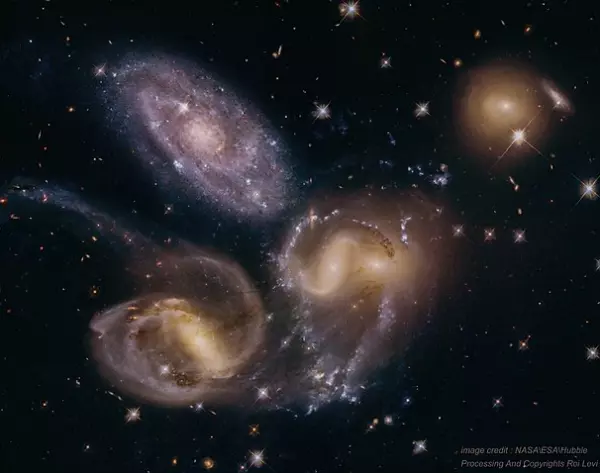
Stephan’s Quintet, image: NASA\ESA\Hubble. Processing and copyrights: Roi Levi (CC BY-SA 4.0)
All five members of Stephan’s Quartet are redshifted, i.e. they are moving away from us. However, NGC 7320 has a considerably smaller redshift – 786 km/s – than the other four galaxies, which are moving away at about 6,600 km/s.
Two of the five galaxies in the visual group are ellipticals – NGC 7317 and NGC 7318A – while the other three – NGC 7318B, NGC 7319, and NGC 7320 – are spiral galaxies. The sixth galaxy, NGC 7320C, is an intermediate spiral.
The interacting galaxies in Stephan’s Quintet will eventually merge into a single large elliptical galaxy. The central pair of galaxies, NGC 7318A and NGC 7318B, have already started to merge with each other. The collision has drawn out long tails of stars from each galaxy and triggered massive bursts of star formation.
The relative proximity of Stephan’s Quintet makes the group a frequent target of studies. The galaxies provide scientists with invaluable insights into galaxy evolution and how interacting galaxies trigger star formation.
The galaxies in the group are being stripped of cool gas by their motion through the hot gas in the intragroup medium and by the gravitational interaction with nearby galaxies. Cool gas is an essential ingredient in forming new stars. The spiral galaxies in the group will likely turn into elliptical galaxies, with minimal star formation activity, a few billion years from now.
The galaxies of Stephan’s Quintet may have lost additional gas in the past few billion years as a result of an intruder passing through the centre of the group. The fainter galaxy NGC 7320C is believed to have been the intruder in question. It may have passed through the centre of the group at least twice in the past.
Stephan’s Quintet galaxies
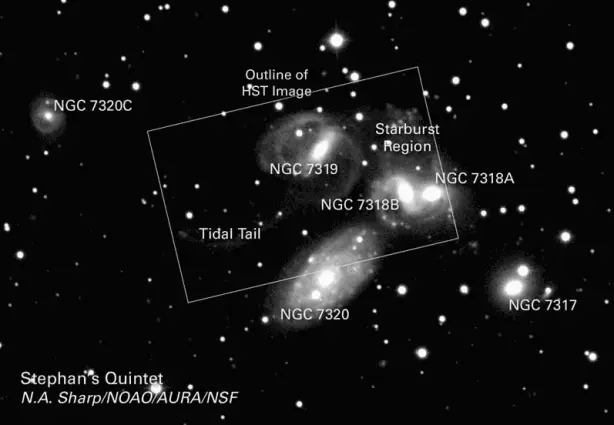
Stephan’s Quintet: NGC 7317, NGC 7318A, NGC 7318B, NGC 7319, NGC 7320, NGC 7320C. Image credit: NASA, J. English (U. Manitoba), S. Hunsberger (PSU), Z. Levay (STScI), S. Gallagher, and J. Charlton (PSU)
NGC 7317
NGC 7317 is classified as an elliptical galaxy (type E4). It has a slightly oval disk and appears less affected by the galactic collision than its neighbours. The galaxy has an apparent magnitude of 14.57 and an apparent size of 0.4 by 0.4 arcminutes. It lies 300 million light-years away. It is also catalogued as HCG 92E.
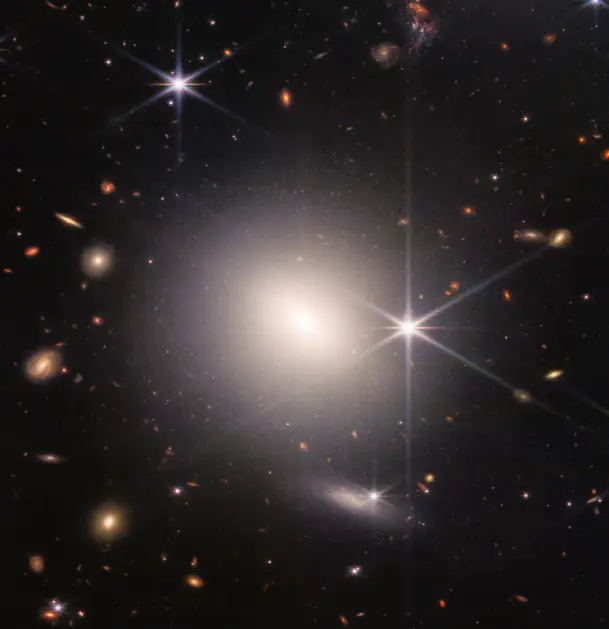
NGC 7317 captured by NASA’s James Webb Space Telescope, credit: NASA, ESA, CSA, and STScI
NGC 7318A and NGC 7318B
NGC 7318A and NGC 7318B (HCG 92D and B) are colliding galaxies that have already begun to merge with one another. They lie approximately 280 million light-years away. At the time of discovery, they were thought to be a single galaxy, and they share the New General Catalogue designation NGC 7318. They are now known to be two separate interacting galaxies.
NGC 7318A is a peculiar elliptical galaxy, and NGC 7318B is classified as a peculiar barred spiral galaxy. In the Hubble image, NGC 7318A appears as the lower galaxy and NGC 7318B is on top. NGC 7318B appears closer to the centre of the group.
NGC 7318A has an apparent magnitude of 14.4 and an apparent size of 0.9 by 0.9 arcminutes. NGC 7318B is slightly brighter and larger, with an apparent magnitude of 13.9 and an angular size of 1.9 by 1.2 arcminutes.
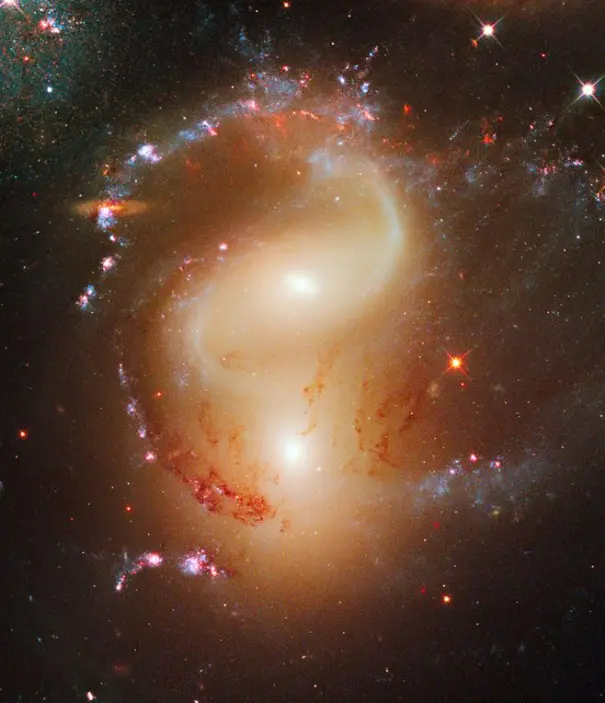
NGC 7318A (bottom) and NGC 7318B (top), image: NASA, ESA, and the Hubble SM4 ERO Team
The galaxies are surrounded by regions of glowing hydrogen where new stars are being born. These stars are less than 10 million years old and still shrouded in their parent clouds.
NGC 7318B is falling into the centre of the group at a speed of several millions of kilometres per hour, causing an enormous intergalactic shock wave. This was first detected through radio observations in the 1970s. A filament of emission between the galaxies was discovered, but its nature was uncertain at the time. In visible light, the same region appears as a green arc. The arc is produced by the faint glow of ionized atomic hydrogen.
Infrared observations with NASA’s Spitzer Space Telescope revealed that the filament was in fact a shock wave caused by NGC 7318B falling into the group’s centre. As the galaxy collides with gas in the intragroup medium, it produces a shock wave larger than the Milky Way, which spreads between the galaxies. The shock wave heats some of the gas in the region to millions of degrees, which causes the gas to glow in the X-ray band. The shock-heated gas was detected by the Chandra X-ray Observatory in 2000.
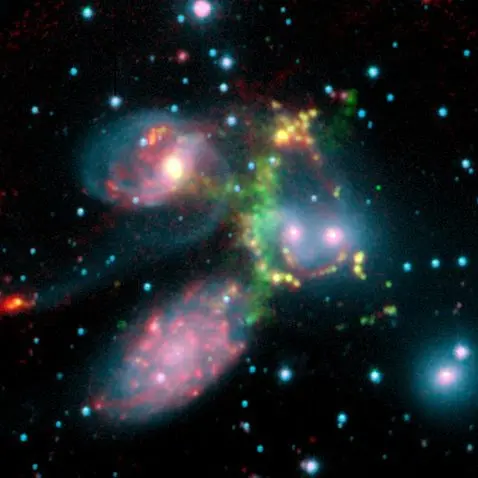
Stephan’s Quintet imaged by the Spitzer Space Telescope, credit: NASA
The Spitzer Space Telescope detected a strong molecular hydrogen emission resulting from the shock wave. It is one of the most turbulent formations of molecular hydrogen ever detected. The strongest emission emanates from an area close to the centre of the green arc seen in visible light images. This phenomenon was detected by an international team of astronomers led by researchers at the California Institute of Technology.
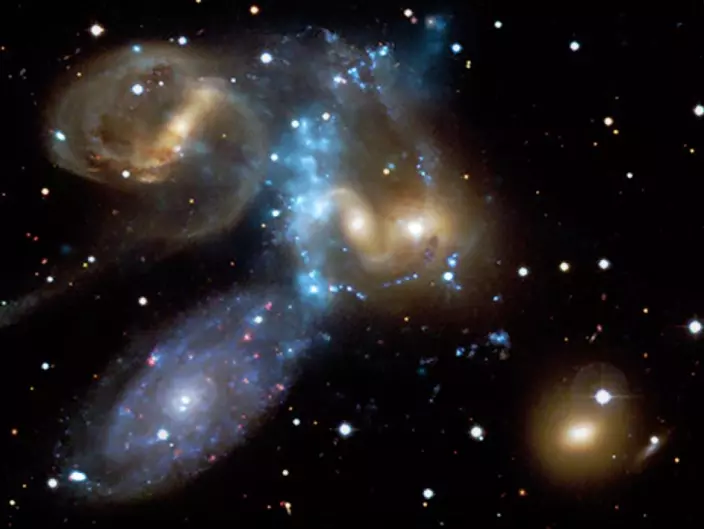
Stephan’s Quintet, a compact group of galaxies discovered about 130 years ago and located about 280 million light years from Earth, provides a rare opportunity to observe a galaxy group in the process of evolving from an X-ray faint system dominated by spiral galaxies to a more developed system dominated by elliptical galaxies and bright X-ray emission. Being able to witness the dramatic effect of collisions in causing this evolution is important for increasing our understanding of the origins of the hot, X-ray bright halos of gas in groups of galaxies. Image Credits: X-ray: NASA/CXC/CfA/E. O’Sullivan Optical: Canada-France-Hawaii-Telescope/Coelum
NGC 7319
NGC 7319 is a barred spiral galaxy highly distorted by the interaction with the other galaxies in the Hickson Compact Group 92. It has distinct spiral arms that trail back almost 180 degrees back to the central bar. The galaxy has an apparent magnitude of 14.4 and an apparent size of 1.7 by 1.3 arcminutes.
NGC 7319 lies 311 million light-years away. It has a type 2 Seyfert nucleus and the characteristic bright core. The galaxy hosts many young clusters of stars in its spiral arms and near the core. The circumnuclear outflow from the galaxy – one of the largest known in a type 2 Seyfert galaxy – reaches velocities of up to 500 km/s and stretches across 13,000 light-years.
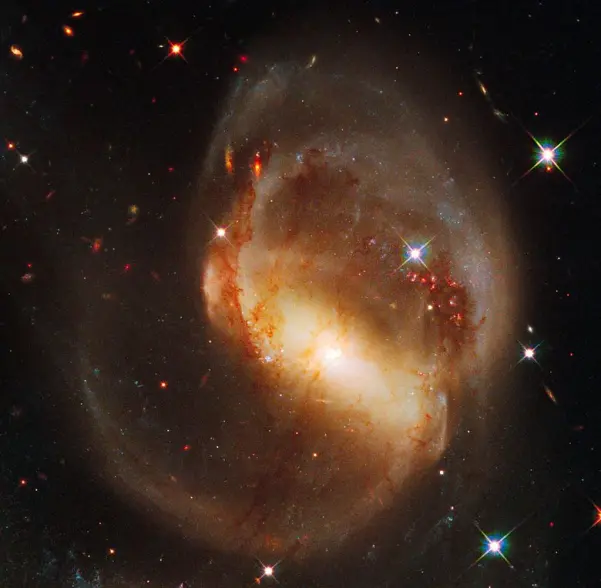
NGC 7319, image: NASA, ESA, and the Hubble SM4 ERO Team
NGC 7319 contains a supermassive black hole with a mass 24 million times that of the Sun. The active galactic nucleus is drawing in material and has an energy output of 40 billion Suns.
The galaxy’s spiral arms appear highly disturbed as a result of the interaction with its neighbours. The galaxy has been stripped of almost all the neutral hydrogen, possibly as a result of a close encounter with NGC 7320C about 100 million years ago. A pair of tidal tails appear to connect the two galaxies. They are sites of star formation.
NGC 7319 is also catalogued as HCG 92C.
NGC 7320
NGC 7320 is a spiral galaxy about 39 million light-years away. It appears as the leftmost galaxy in the James Webb Space Telescope image of the group. With an apparent magnitude of 13.2, it is the brightest member of Stephan’s Quintet. However, it is not physically associated with the other four galaxies. It has a small redshift (about 790 km/s), while the other galaxies have redshifts of almost 6,600 km/s.
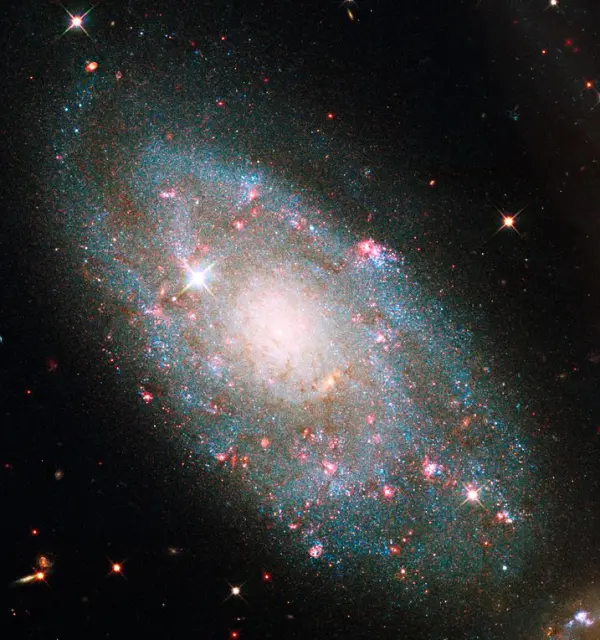
NGC 7320 by the Hubble Space Telescope, credit: NASA, ESA, and the Hubble SM4 ERO Team
NGC 7320 is about seven times closer than the rest of the group. It has an apparent size of 2.2 by 1.2 arcminutes. It is catalogued as HCG 92A, even though it is a foreground galaxy and not a member of the group.
The galaxy contains vast HII regions where new stars are being formed. It may be a member of the Deer Lick Group (NGC 7331 Group). It has a similar redshift and lies at a similar distance as the nearby NGC 7331 (39.8 million light-years).
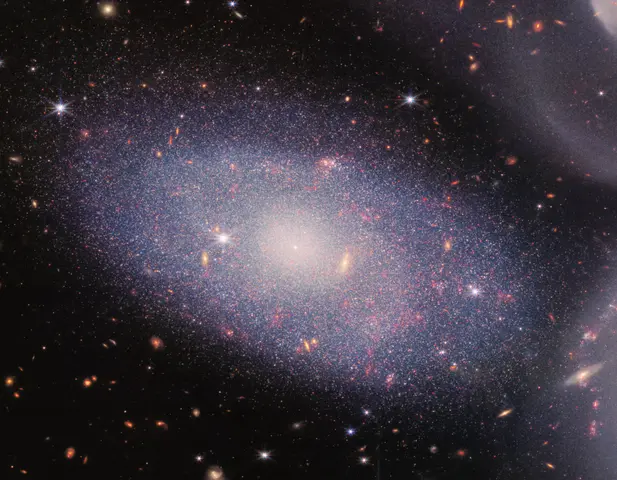
NGC 7320 by the James Webb Space Telescope, credit: NASA, ESA, CSA, STScI
NGC 7320C
NGC 7320C, a sixth galaxy that appears in a wider field, is a likely member of the Hickson Compact Group 92 based on its redshift. The galaxy has an apparent magnitude of 16.7 and an apparent size of 0.7 by 0.6 arcminutes. It is smaller and fainter than the galaxies of Stephan’s Quintet.
NGC 7320C appears southeast of the main group. It is not a member of the visual grouping but is believed to have passed through the group from behind a few hundred million years ago and collided with the four galaxies. The galaxy exhibits a long tidal tail – a trail of stars ripped out during the interaction – that appears to connect it with NGC 7319.
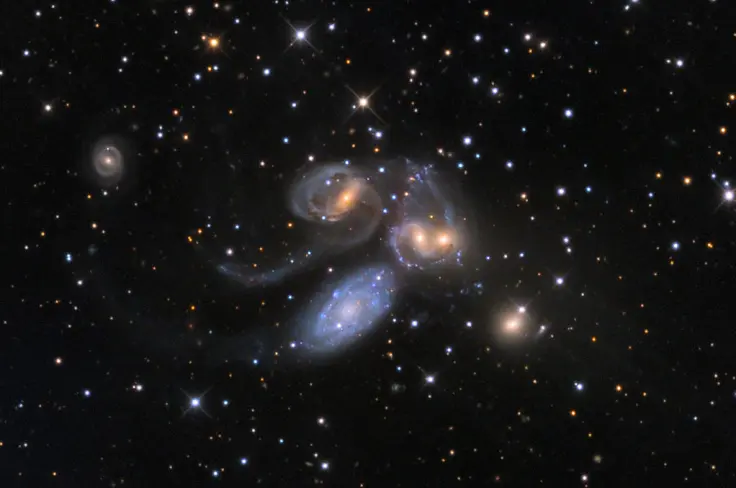
Stephan’s Quintet and NGC 7320C, image: Adam Block/Mount Lemmon SkyCenter/University of Arizona (CC BY-SA 4.0)
Hubble Space Telescope image
Stephan’s Quintet was imaged by the Hubble Space Telescope in 1998-1999 and 2008-2009. In 1998-99 Hubble’s Wide Field and Planetary Camera 2 (WFPC2) captured the central region of the group and put an end to the debate concerning the redshift of NGC 7320. The high resolution of the telescope allowed astronomers to see individual stars in the galaxy, showing that it was definitely closer to us than the other four.
The data obtained with Hubble also showed that the galaxies NGC 7320C and NGC 7318B were not physically bound to the group, but merely passing through. The quintet of galaxies is really a triplet consisting of NGC 7317, NGC 7318A, and NGC 7319. The two interlopers are just visiting and preventing the three galaxies from completely merging with each other. The Hubble image even showed the formation of a compact dwarf galaxy in the tidal tail of NGC 7319.
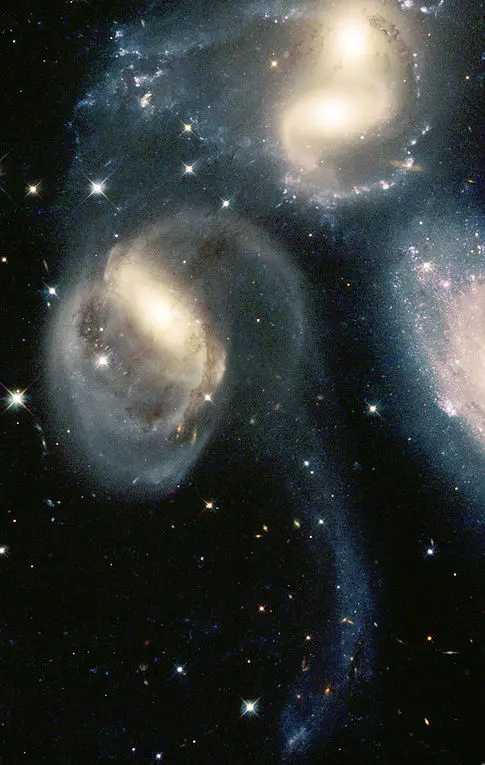
The NASA Hubble Space Telescope photo showcases three regions of star birth: the long, sweeping tail and spiral arms of NGC 7319 [near center]; the gaseous debris of two galaxies, NGC 7318B and NGC 7318A [top right]; and the area north of those galaxies, dubbed the northern starburst region [top left]. The clusters’ bluish color indicates that they’re relatively young. Their ages span from about 2 million to more than 1 billion years old. The brilliant star clusters in NGC 7318B’s spiral arm (about 30,000 light-years long) and the northern starburst region are between 2 million and more than 100 million years old. NGC 7318B instigated the starburst by barreling through the region. The bully galaxy is just below NGC 7318A at top right. Although NGC 7318B appears dangerously close to NGC 7318A, it’s traveling too fast to merge with its close neighbor. The partial galaxy on the far right is NGC 7320, a foreground galaxy not physically bound to the other galaxies in the picture.
About 20 to 50 of the clusters in the northern starburst region reside far from the coziness of galaxies. The clusters were born about 150,000 light-years from the nearest galaxy. Image: NASA, Jayanne English (University of Manitoba), Sally Hunsberger (Pennsylvania State University), Zolt Levay (Space Telescope Science Institute), Sarah Gallagher (Pennsylvania State University), and Jane Charlton (Pennsylvania State University)
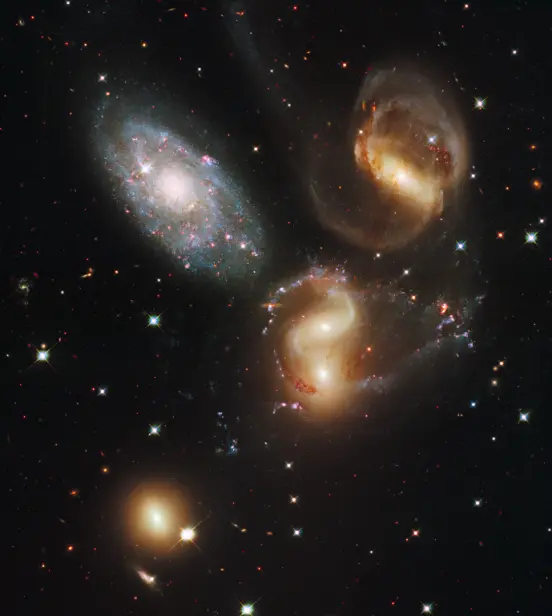
This portrait of Stephan’s Quintet, also known as Hickson Compact Group 92, was taken by the new Wide Field Camera 3 (WFC3) aboard NASA’s Hubble Space Telescope. Stephan’s Quintet, as the name implies, is a group of five galaxies. The name, however, is a bit of a misnomer. Studies have shown that group member NGC 7320, at upper left, is actually a foreground galaxy about seven times closer to Earth than the rest of the group.
Three of the galaxies have distorted shapes, elongated spiral arms, and long, gaseous tidal tails containing myriad star clusters, proof of their close encounters. These interactions have sparked a frenzy of star birth in the central pair of galaxies. This drama is being played out against a rich backdrop of faraway galaxies. Image credit: NASA, ESA, and the Hubble SM4 ERO Team
James Webb Space Telescope image
Stephan’s Quintet was one of the first objects captured by NASA’s James Webb Space Telescope (JWST). The group of galaxies was imaged using the Mid-Infrared Instrument (MIRI), Near-Infrared Spectrograph (NIRSpec), and Near-Infrared Camera (NIRCam). The resulting images revealed previously unseen details in the galaxy group, shedding new light on galactic interactions and the ways they trigger star formation.
MIRI and NIRSpec captured the active galactic nucleus of NGC 7319, the topmost galaxy in the JWST image, through the dust that surrounds it, and uncovered previously unseen regions of star formation. The instruments were able to see the gas near the central black hole and determine its composition. They showed that the black hole was surrounded by silicate dust. The spectrum of the black hole’s outflow revealed a region of hot gases, including neon, oxygen, sulfur, iron, and argon.
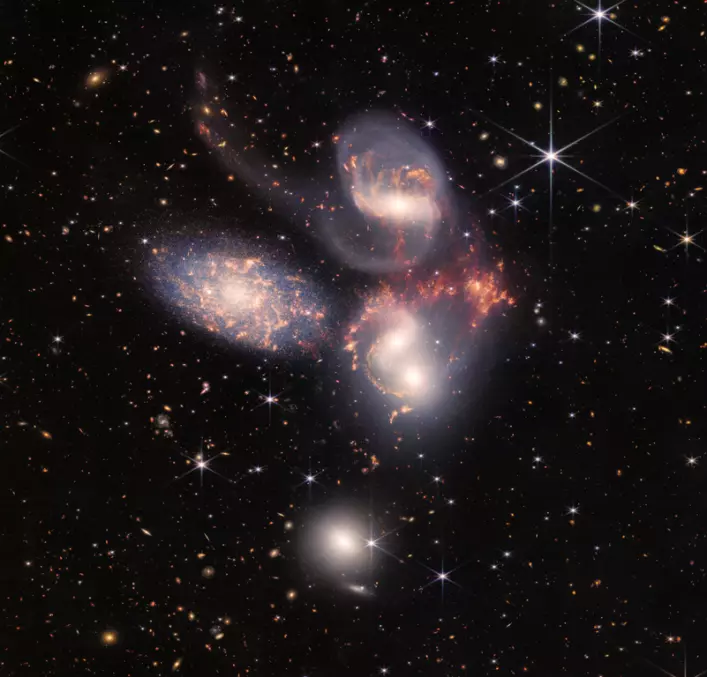
With its powerful, infrared vision and extremely high spatial resolution, Webb shows never-before-seen details in this galaxy group. Sparkling clusters of millions of young stars and starburst regions of fresh star birth grace the image. Sweeping tails of gas, dust and stars are being pulled from several of the galaxies due to gravitational interactions. Most dramatically, Webb’s MIRI instrument captures huge shock waves as one of the galaxies, NGC 7318B, smashes through the cluster. These regions surrounding the central pair of galaxies are shown in the colors red and gold. This composite NIRCam-MIRI image uses two of the three MIRI filters to best show and differentiate the hot dust and structure within the galaxy. MIRI sees a distinct difference in color between the dust in the galaxies versus the shock waves between the interacting galaxies. The image processing specialists at the Space Telescope Science Institute in Baltimore opted to highlight that difference by giving MIRI data the distinct yellow and orange colors, in contrast to the blue and white colors assigned to stars at NIRCam’s wavelengths. Credit: NASA, ESA, CSA, STScI
MIRI was developed by a consortium of European institutes (the MIRI European Consortium) and the Jet Propulsion Laboratory (JPL). NIRCam was built by a team at the University of Arizona and Lockheed Martin’s Advanced Technology Center. NIRSpec was built for the European Space Agency (ESA) by Airbus Industries and Space (ADS), and NASA’s Goddard Space Flight Center provided the micro-shutter subsystems.
The NIRCam and MIRI mosaic image was the largest image captured by the James Webb telescope at the time of release, covering about one-fifth of the Moon’s diameter. The field of view in the composite image is about 620,000 light-years across, and the MIRI image shows a field about 370,000 light-years across. The composite image was created using almost a thousand separate image files and contains more than 150 million pixels.
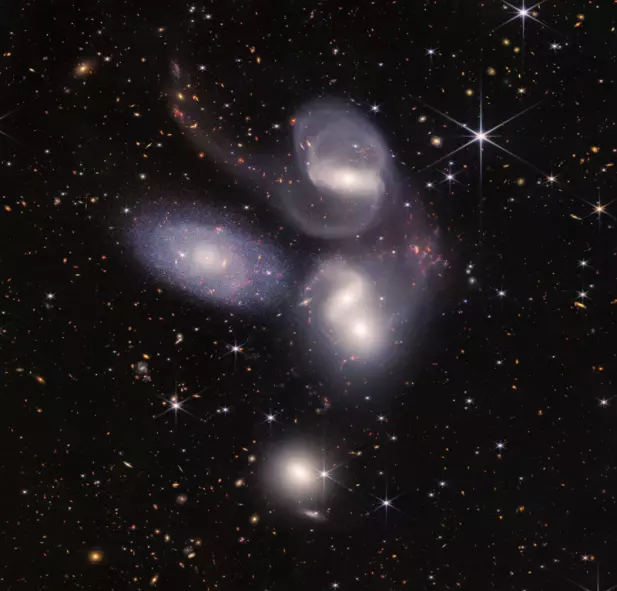
Stephan’s Quintet imaged by JWST’s Near-Infrared Camera (NIRCAM). Image: NASA, ESA, CSA, STScI
Scientists believe that tight groups of galaxies like HCG 92 may have been more common in the early universe. When the universe was very young, hot infalling material may have provided fodder for highly energetic black holes (quasars). The JWST image provides astronomers with new insights into the ways galactic collisions and interactions may have affected the evolution of galaxies when the universe was much younger.
The image reveals millions of young stars in open clusters, tails of gas, dust and stars drawn from the galaxies as a result of the collision, and huge shock waves produced by NGC 7318B as it crashes through the group. The James Webb telescope was able to resolve the bright core of NGC 7320, as well as individual stars. As a bonus, it offered a much clearer view of the distant background galaxies. The sight of the distant galaxies is reminiscent of Hubble’s deep fields.
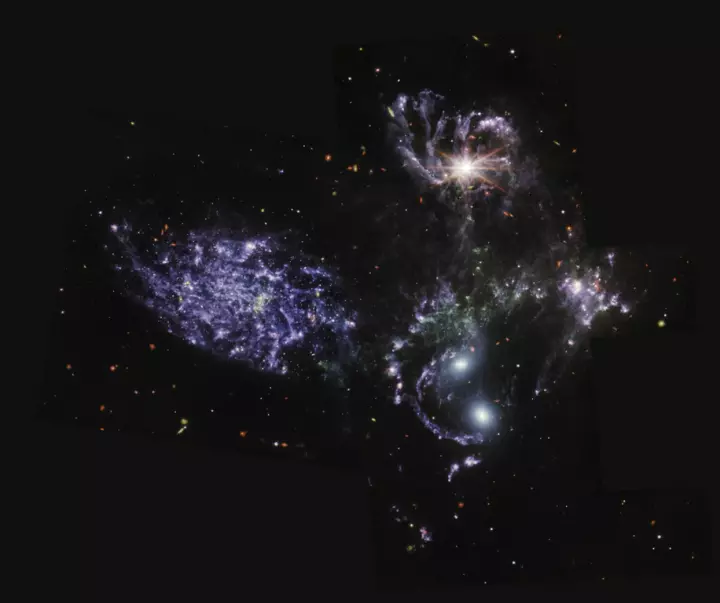
Here’s Stephan’s Quintet as taken by Webb’s MIRI instrument. In the mid-infrared, Webb pierces through dust, giving new insight into how interactions like these may have driven galaxy evolution in the early universe.
This image contains one more MIRI filter than was used in the NIRCam-MIRI composite picture. The image processing specialists at the Space Telescope Science Institute in Baltimore opted to use all three MIRI filters and the colors red, green and blue to most clearly differentiate the galaxy features from each other and the shock waves between the galaxies. In this image, red denotes dusty, star-forming regions, as well as extremely distant, early galaxies and galaxies enshrouded in thick dust. Blue point sources show stars or star clusters without dust. Diffuse areas of blue indicate dust that has a significant amount of large hydrocarbon molecules. For small background galaxies scattered throughout the image, the green and yellow colors represent more distant, earlier galaxies that are rich in these hydro carbons as well. Credit: NASA, ESA, CSA, STScI
The JWST image also reveals outflows from the supermassive black hole in NGC 7319 in unprecedented detail. The data obtained by the telescope will allow astronomers to measure the velocity of the outflows.
The James Webb Space Telescope (JWST) was developed by the U.S. National Aeronautics and Space Administration (NASA) with the European Space Agency (ESA) and the Canadian Space Agency (CSA). The telescope is operated by the Space Telescope Science Institute (STScI) in Baltimore, Maryland.
The study of the evolution and formation of galaxies is one of Webb’s telescope’s primary missions. Webb’s high spatial resolution will also help astronomers understand star and planet formation and explore the distant universe to obtain new information about the first stars and galaxies that formed after the Big Bang. The infrared vision of the JWST sees through the obscuring dust, allowing the observation of dimmer and cooler objects. The telescope is a successor both to the Hubble Space Telescope (HST) and the Spitzer Space Telescope.
Facts
Stephan’s Quintet was one of the first targets of NASA’s James Webb Space Telescope (JWST). It was selected as one of the five objects to be imaged as part of the first official JWST release. The other four objects were the Carina Nebula, a vast stellar nursery in the constellation Carina, a deep field view of the galaxy cluster SMACS 0723 in Volans, the Southern Ring Nebula (NGC 3132) in Vela, and the transmission spectrum of the exoplanet WASP-96b, which orbits the Sun-like star WASP-96 in Phoenix.
Studies of Stephan’s Quintet were often used in the debate regarding redshift as a measure of distance. English astronomers Geoffrey and Margaret Burbridge obtained the spectra of the five galaxies in 1961 and found that NGC 7230 was receding from Earth much less rapidly than the other four galaxies. Some astronomers took this as evidence that distance and redshift are not related. Today, most astronomers agree that the galaxy lies in the foreground and that the Quintet is in part a chance alignment.
A telescopic image of Stephan’s Quintet makes an appearance in Frank Capra’s 1946 holiday classic film It’s a Wonderful Life. The angels who hear prayers for George Bailey (James Stewart) at the beginning of the film are represented by the galaxies. The angel Joseph is played by the foreground galaxy NGC 7320 and the Senior Angel by the galaxy pair NGC 7318.
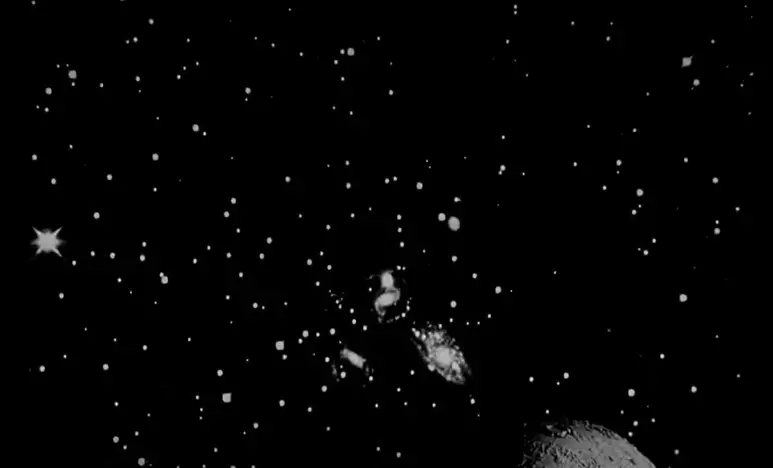
Stephan’s Quintet in It’s a Wonderful Life (1946), Liberty Films
Stephan’s Quintet and NGC 7331
Stephan’s Quintet and the nearby NGC 7331 Group (the Deer Lick Group) are among the most popular astrophotography targets in the northern sky. The two galaxy groups appear close in the sky and can be captured in the same wide field of view.
NGC 7331 is a much brighter and larger unbarred spiral galaxy located approximately 39.8 million light-years away. With an apparent magnitude of 10.4 and an apparent size of 10.5 by 3.7 arcminutes, the galaxy can be observed in small telescopes. It has a diameter of 120,000 light-years.
NGC 7331 is the brightest galaxy in the Deer Lick Group, a visual grouping of galaxies that are not gravitationally associated, but merely appear in the same line of sight. Like NGC 7320 in Stephan’s Quintet, NGC 7331 lies in the foreground, while the other galaxies – NGC 7335, NGC 7336, NGC 7337, and NGC 7340 – lie at greater distances of 332, 365, 348 and 294 million light-years away, respectively.
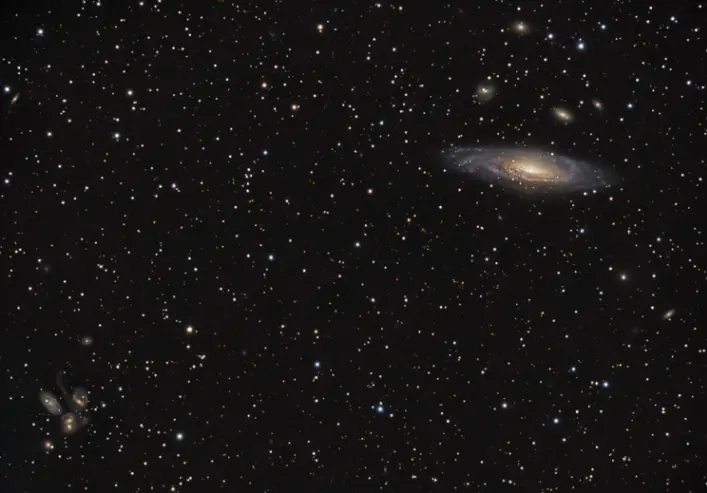
NGC 7331 Group (the Deer Lick Group, right) and Stephan’s Quintet (left), image: Wikimedia Commons/Stargazer 7000
Location
Stephan’s Quintet is located in the constellation Pegasus, near the border with Lacerta. It can be found using the bright stars Scheat (Beta Pegasi) and Matar (Eta Pegasi). Scheat is part of the Great Square of Pegasus, along with Algenib, Markab and Alpheratz. The bright asterism is one of the most familiar features of the northern autumn sky. Matar is found in the direction of Lacerta and Cygnus. The interacting galaxies lie about a quarter of the way from Scheat to Deneb, the brightest star in Cygnus.
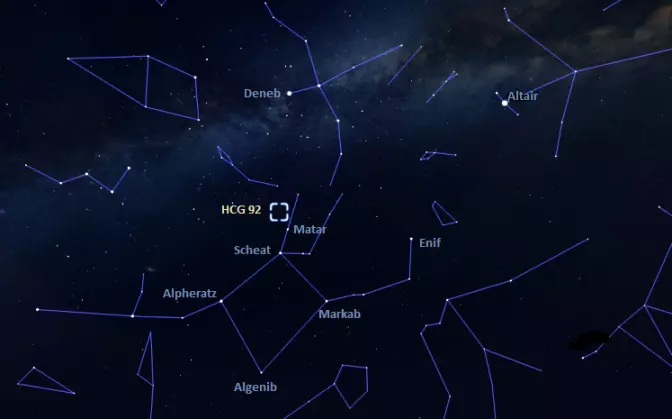
The location of Stephan’s Quintet in Pegasus, image: Stellarium
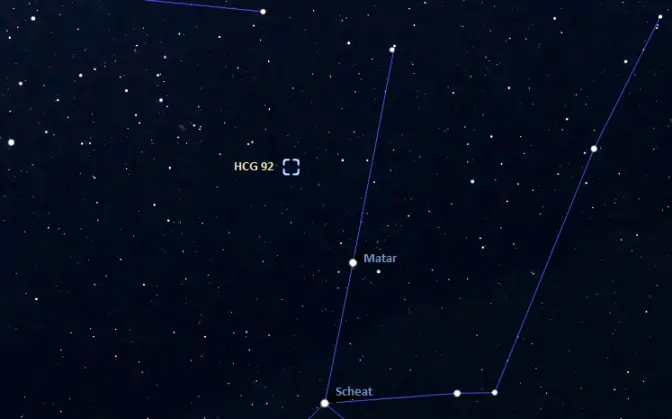
Scheat, Matar and Stephan’s Quintet, image: Stellarium
Constellation
Stephan’s Quintet lies in the northern part of Pegasus. Pegasus is one of the largest northern constellations. Representing the mythical winged horse, the constellation stretches across 1,121 square degrees of the sky and is the seventh largest of the 88 constellations. Its brightest star, Enif (Epsilon Pegasi), marks the horse’s muzzle.
Pegasus is recognizable for the Square of Pegasus, an asterism formed by three Pegasus stars – Algenib, Scheat and Markab – with Alpheratz, the brightest star in the neighbouring Andromeda. The asterism can be used to find many notable deep sky objects in this region of the sky, including the Andromeda Galaxy (M31), the Triangulum Galaxy (M33), and the spiral galaxy Messier 74 (the Phantom Galaxy).
The best time of year to observe the deep sky objects in Pegasus is during the autumn months, when the constellation is prominent in the evening sky.
Stephan’s Quintet
| Constellation | Pegasus |
| Right ascension | 22h 35m 57.5s |
| Declination | +33° 57′ 36″ |
| Names and designations | Stephan’s Quintet, HCG 92, Arp 319, VV 288 |
NGC 7317
| Type | E4 |
| Apparent magnitude | 14.57 |
| Apparent size | 0′.4 x 0′.4 |
| Distance | 300 million light-years |
| Redshift | 6,599 ± 26 km/s |
| Right ascension | 22h 35m 51.9s |
| Declination | +33° 56′ 43″ |
| Designations | NGC 7317, HCG 92E, PGC 69256, Z 514.60, MCG+06-49-038 |
NGC 7318A
| Type | E2 pec |
| Apparent magnitude | 14.4 |
| Apparent size | 0′.9 x 0′.9 |
| Distance | 280 million light-years |
| Redshift | 6,630 ± 23 km/s |
| Right ascension | 22h 35m 56.7s |
| Declination | +33° 57′ 56″ |
| Designations | NGC 7318A, HCG 92D, UGC 12099, PGC 69260, Z 514-61, MCG+06-49-039 |
NGC 7318B
| Type | SB(s)bc pec |
| Apparent magnitude | 13.9 |
| Apparent size | 1′.9 x 1′.2 |
| Distance | 280 million light-years |
| Redshift | 5,774 ± 24 km/s |
| Right ascension | 22h 35m 58.4s |
| Declination | +33° 57′ 57″ |
| Designations | NGC 7318B, HCG 92B, UGC 12100, PGC 69263, MCG+06-49-040, Z 514-62 |
NGC 7319
| Type | SB(s)bc pec |
| Apparent magnitude | 14.1 |
| Apparent size | 1′.7 x 1′.3 |
| Distance | 311 million light-years |
| Redshift | 6,740 km/s |
| Right ascension | 22h 36m 03.56s |
| Declination | +33° 58′ 32.7″ |
| Designations | NGC 7319, HCG 92C, UGC 12102, PGC 69269, MCG+06-49-041, Z 514-64 |
NGC 7320
| Type | SA(s)d |
| Apparent magnitude | 13.2 |
| Apparent size | 2′.2 x 1′.2 |
| Distance | 39 million light-years |
| Redshift | 786 ± 20 km/s |
| Right ascension | 22h 36m 03.4s |
| Declination | +33° 56′ 53″ |
| Designations | NGC 7320, HCG 92A, UGC 12101, PGC 69270, MCG+06-49-042, Z 514-63 |
NGC 7320C
| Type | (R)SAB(s)0/a |
| Apparent magnitude | 16.7 |
| Apparent size | 0′.7 x 0′.6 |
| Redshift | 5,985 ± 9 km/s |
| Right ascension | 22h 36m 20.4s |
| Declination | +33° 59′ 6″ |
| Designations | NGC 7320C, PGC 69279, MCG+06-49-043 |